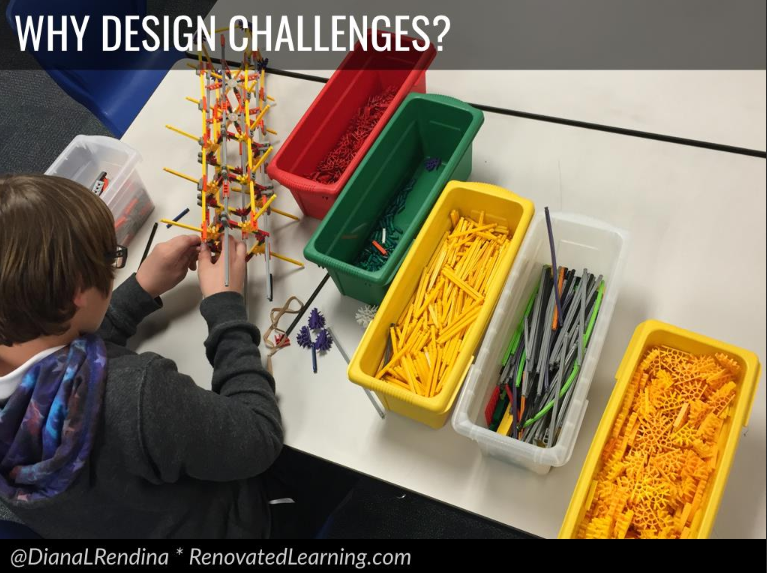Challenge-based learning projects in the makerspace have many benefits for students, and can engage and get them excited about new projects.
In “Challenge-Based Learning in the School Library Makerspace,” Diana Rendina, media specialist and writer for Tampa Preparatory School, Tampa, FL, presented tips for design challenges and shared experiences from working in the makerspace during her time at Stewart Middle Magnet School in Tampa, FL.
When Rendina first started her position at Stewart Middle Magnet School, a public STEM magnet school, there was almost nothing in the library for hands-on STEM learning. Diana worked with the students to form a makerspace planning committee, and eventually raised money to transform a corner of the library into a dedicated makerspace.
Students worked on projects through open exploration, consisting of mainly free time in the makerspace; workshops, in which students work in groups to learn new skills; and design challenges, in which a group of students focuses on a specific challenge directed by a prompt.

Design Challenges for Better Makerspaces
Design challenges are one of the most effective ways to get students engaged in the makerspace.
1. Start with a Design Prompt
Rendina noted that it is helpful for the students to start with a design prompt to define clear guidelines and the purpose of the challenge.

Some of the challenges Rendina did with her students include the Rubber Band Launcher Challenge, where the students must build a device that could launch something and must include a rubber band in their design; the Cardboard Challenge, an open-ended challenge where the students must create something using at least 75 percent cardboard; and the Phone/Tablet Holder, where students build a device that can hold a phone steady to take picture or video.
(Next page: More musts for a better makerspace)
2. Help Teachers Connect Challenges to Curriculum
Teachers often don’t have extra time for projects outside of the school curriculum, so Diana worked with teachers to connect design challenges in the makerspace to the curriculum.
In one example, during a science lesson in which students were learning about artificial reefs, the students first annotated and engaged with different texts about artificial reefs. Then, using at least one piece of evidence they read about, they had to build their own artificial reefs in the makerspace and present their projects to the class.
Like this example, many of these curriculum-related lessons can be done within one class period.
3. Organize
Rendina recommended some best practices for design challenges and other makerspace activities. First, label everything so students can be self-sufficient and find things on their own. Project storage is important too. If you have the space, save your students’ projects so they can work on them later.
4. Think Less is More
While some guidelines for design challenges are helpful, less instruction is still more. Instead of answers, try only to provide guidance, suggestions, and leading questions.
5. Let the Work Shine

Finally, have a display area. “It helps to honor the students’ work, it shows that the things they’re making in the makerspace have value and that you care about it and want other students to see it. That makes a really big difference in creating that maker culture for the school,” Rendina said.
About the Presenter
Diana Rendina, MLIS, is the media specialist at Tampa Preparatory School in Tampa, FL. Prior to this, she was the media specialist at Stewart Middle Magnet School, where she transformed their library and piloted their makerspace program. Diana, the winner of the 2016 ISTE Outstanding Young Educator Award and the 2015 AASL Frances Henne Award for emerging leaders, is active in the ISTE Librarians Network, AASL and FAME. She is an international speaker on the Maker Movement and learning space design. Diana is a coauthor of Challenge-Based Learning in the School Library Makerspace, the author of Reimagining Library Spaces: Transform Your Space on Any Budget, and a monthly contributor to AASL Knowledge Quest. Find her online at her blog RenovatedLearning.com and on Twitter @DianaLRendina.
Join the Community
SLC @ the Forefront is a free professional learning community that offers school librarians and educators alike a place to explore together the challenges, opportunities and resources that make school libraries vibrant, vital research and learning environment.
This broadcast was hosted by edWeb.net and sponsored by Libraries Unlimited.
The recording of the edWebinar can be viewed by anyone here.
[Editor’s note: This piece is original content produced by edWeb.net. View more edWeb.net events here.]
- #4: 25 education trends for 2018 - December 26, 2018
- Video of the Week: Dealing with digital distraction in the classroom - February 23, 2018
- Secrets from the library lines: 5 ways schools can boost digital engagement - January 2, 2018

